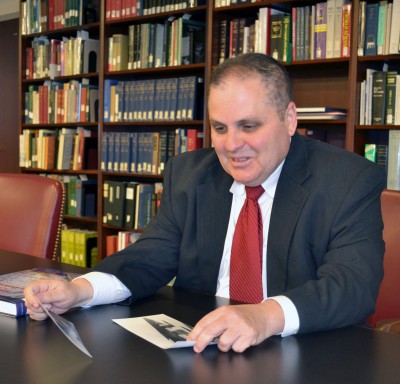
Richard Schwartz, fascinated by meteorology since he was a child, did more than 100 interviews and worked for seven years on his book "Hurricanes and the Middle Atlantic States." (Photo: Lauren Redding)
COLLEGE PARK, Md.—When Richard Schwartz sat down for lunch at Captain Billy’s Crab House in Southern Maryland in 2000, all he was expecting to get was a quick crab cake sandwich.
What he ended up getting was a glimpse into hurricane history that changed the rest of his life.
Adorning the walls of Captain Billy’s—an old-fashioned seafood joint on the Potomac River in Newburg—were photos of the aftermath of Hurricane Hazel, a Category 4 storm that slammed the Mid-Atlantic in 1954 with wind gusts up to 100 miles an hour. Captain Billy’s was nearly destroyed. In fact, during repairs, the original Billy had to remove his fishing boat from the dining room.
“I remember thinking, ‘How in the world could a hurricane do damage like that in Southern Maryland?’ ” said Schwartz, a short man with a kind, round face and a soft voice. “I thought storms like that could only happen off the coast of Florida.”
Schwartz, 57, left Captain Billy’s that day with a plan: He would finally write the book he had always dreamed of—the history of Mid-Atlantic hurricanes.
The finished product, published in August 2007, is titled “Hurricanes and the Middle Atlantic States.” Schwartz spent seven years researching and writing, traveling more than 10,000 miles up and down the East Coast and conducting more than 100 interviews with people who had survived storms like Hazel.
“I thought I’d be lucky to get 100 pages,” Schwartz said. “The book turned out to be 400 pages.”
Schwartz published the book himself—which required taking out a second mortgage on his Springfield, Va., home to finance the project.
“It’s definitely a labor of love,” Schwartz said, looking down at his book fondly, like it was an old friend. “No one wants to pay money for hurricane research, but I felt it needed to be done. I felt it was my mission.”
Schwartz has always had an interest in writing and history, he said, especially in college. He spent his first year at Montgomery Community College and then transferred to the University of Maryland, majoring in business, minoring in journalism and reporting at the independent, student newspaper, The Diamondback.
But Schwartz says he wanted the small-school experience before graduating. Eventually, he transferred to Salisbury University to complete college. He graduated in 1982 with a degree in Liberal Studies.
In 1975, at Montgomery Community College, Schwartz joined the college’s Meteorology Club and met the man who would become his best friend, Peter Gajary. Gajary served as president of the club and Schwartz served as the club’s public relations officer.
“Rick was very instrumental in connecting people from distant backgrounds to each other,” said Gajary, a geospatial analyst at the U.S. Department of Agriculture. “He was always fascinated by the power of hurricanes. He was absolutely an expert on the subject from the very get-go.”
Schwartz got an offer for a newspaper job in Salisbury after graduation, but entry-level reporter positions didn’t pay much. So he took a research position with a government defense contractor, always hoping he’d one day write a book.
“When you’re a writer, that’s the ultimate goal,” he said. “It’s great doing articles, but articles are here today, forgotten tomorrow. A nonfiction book, with information that will be available and pertinent to society on an ongoing basis, was always my goal.”
Schwartz had an interest in weather since he was young, he said, but his passionate curiosity for hurricanes developed in 1972 when he survived his first big storm, Hurricane Agnes. The Category 1 storm brought severe flooding to the Mid-Atlantic, killed 117 people and totaled about $3.1 billion in damages.
At the time, 17-year-old Schwartz was living with his parents in Rockville. Their house was built on high ground, but Schwartz said he remembers waters from a nearby creek rising more than 10 feet.
“I saw water in places I never thought I would see it,” he said. “The whole Mid-Atlantic region was devastated. The damage from the flooding was unbelievable.”
Agnes is just one of dozens of storms from 1609 to 1993 that Schwartz profiled in his book, which combines anecdotes from residents who lived through the events, quotes from newspaper articles, historical records, damages and death tolls. The book is filled with photos of the major damage that Mid-Atlantic hurricanes have inflicted — including young boys canoeing down a flooded street in Trenton, N.J., in 1903 and a railroad bridge collapse that led to a “deadly train derailment outside Washington, D.C.” in 1933.
The idea for Schwartz’ book was refined in Gajary’s Washington apartment, Gajary said. The pair spent many hours walking around Gajary’s Adams Morgan neighborhood, hashing out plans.
“I said, ‘Well, this is it. He’s got to do it.’ ” Gajary said. “I wasn’t surprised he came up with it because he’s a big idea man. Finally, things really came together. Over the years, he would call and sometimes he was discouraged, and I’d say, ‘Nope, go on, go on, go on.’ ”
Schwartz said the book has sold more than 1,000 copies, mostly to local and college libraries—the Library of Congress has two copies, he says—and he’s been able to pay off the second mortgage.
This March, Schwartz spoke at the National Hurricane Conference in New Orleans. With more than 1,000 people in attendance every year, the meeting, Schwartz said, is considered the “big league” of hurricane conferences. In May, he spoke at the Maryland Emergency Management Association’s annual conference in Ocean City.
“Slowly but surely, this book has worked its way up there,” he said. “I’ve come a long way since just doing my research. I’m just glad that I can share my findings with important people in the field.”
Schwartz is writing similar books on hurricane history in New England and the Southern states.


